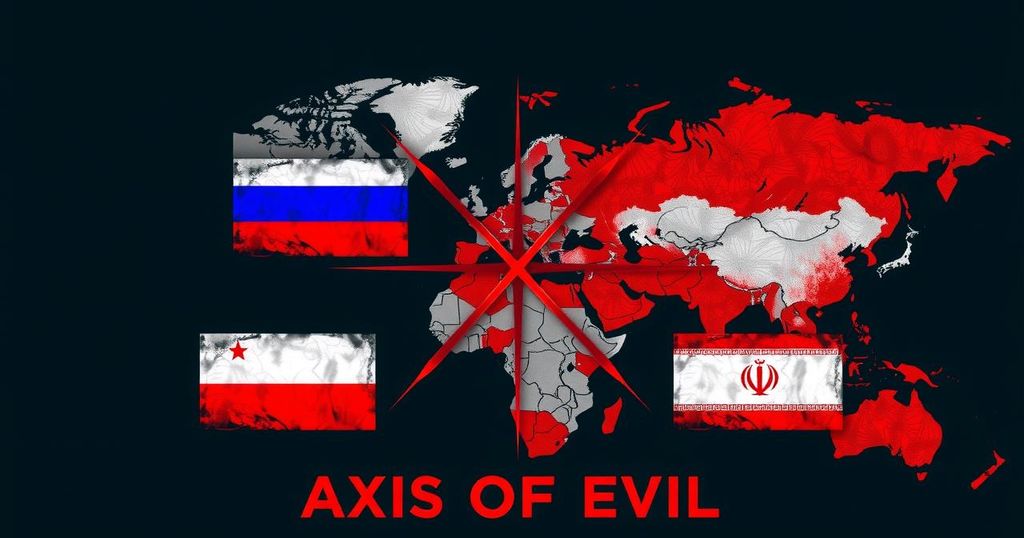U.S. officials express growing concerns over an emerging alliance among China, Russia, North Korea, and Iran, termed a new “Axis of Evil.” North Korean troops are reportedly assisting Russia in its war against Ukraine, while Iran and China support Russia militarily. Experts warn that this bloc poses significant challenges to the United States and its allies, underscoring the threat of coordinated aggression across different regions.
The geopolitical landscape is witnessing the emergence of a collaborative bloc comprised of China, Russia, North Korea, and Iran, which some U.S. officials are referring to as a new “Axis of Evil.” This term, echoing the language of previous U.S. administrations, particularly refers to the alliances formed between nations deemed hostile to democratic values and international norms. U.S. Defense Secretary Lloyd Austin recently confirmed the presence of North Korean troops in Russia, presumably preparing to support Russian military efforts in Ukraine, further solidifying concerns regarding this growing partnership. Moreover, this collaborative effort is underpinned by the support that China, North Korea, and Iran have extended to Russia during the ongoing conflict in Ukraine. North Korea has provided artillery shells, Iran has supplied missiles and drones, while China has assisted with dual-use technology and industrial products. Representative Rob Wittman, vice chairman of the House Armed Services Committee, emphasized the seriousness of the situation by drawing parallels to the prelude of World War II, stating, “We find ourselves at that same crossroads today where we have nations that do not believe in the same things that we believe in, do not believe in the rule of law, do not believe in protecting the rights and dignity of human beings.” U.S. Secretary of State Antony Blinken has characterized these four nations as revisionist powers, engaged in a fierce competition to redefine the global order. He does not label them as a formal axis, but acknowledges that their collective choices necessitate a decisive response from the United States and its allies. In discussions regarding their capabilities, analysts have highlighted that the collaboration between these nations is more sophisticated than previous historical threats. Merrill Matthews of the Institute for Policy Innovation warned of their expansionist ambitions, suggesting they aim to create a self-sufficient economic zone that does not rely on Western economies. Furthermore, Christopher S. Chivvis at the Carnegie Endowment for International Peace underscored the importance of China’s role in this partnership; without it, the potential threat would be substantially diminished. Amid these developments, the dynamics of international relations remain precarious. The possibility of coordinated military actions, as suggested by Chivvis, suggests that a crisis in one region could incite aggression elsewhere, particularly illustrated by scenarios involving Taiwan and the Middle East. Meanwhile, despite the transactional nature of this alliance, Blinken observes that the overarching objective of these states remains a unified challenge against the U.S. and the prevailing international order, further complicating the global geopolitical landscape.
The term “Axis of Evil” has historical roots dating back to former U.S. President George W. Bush’s 2002 State of the Union address, which identified nations that supported terrorism. Given the current geopolitical tensions, recent assessments have led officials to reapply the term to describe a coalition of nations that threaten democratic values and international stability. The alliance comprises China, Russia, North Korea, and Iran, each contributing to military and technological support amidst their respective regional conflicts, particularly regarding the war in Ukraine. This collaboration raises significant concerns as analysts draw parallels to historical aggressors, suggesting a coordinated approach to destabilize the international order.
In conclusion, the evolving partnership among China, Russia, North Korea, and Iran represents a formidable challenge to U.S. interests and global stability. While some scholars argue that their relationship is mainly transactional, the strategic implications of their alliances could lead to coordinated military actions and destabilization in various regions. The international community must remain vigilant as these nations increase cooperation and share technology against a backdrop of hostile intentions toward democratic norms.
Original Source: www.voanews.com






